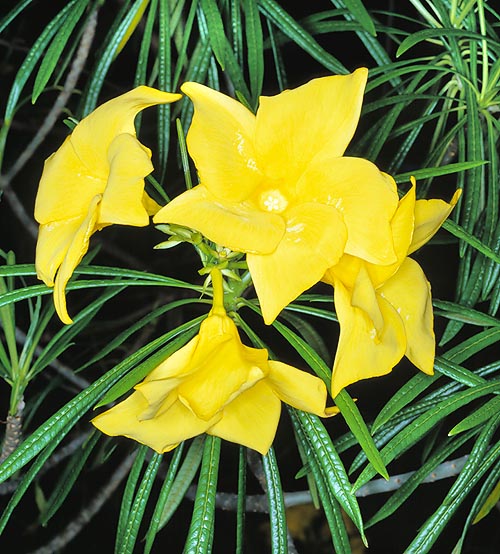Family : Apocynaceae

Text © Pietro Puccio

English translation by Mario Beltramini

Resembles to the Cascabela thevetia, but has greater flowers © Giuseppe Mazza
The name of the genus comes from the name “cascabel” with which the plant is called by the native populations; the name of the species “thevetioides” = similar to the thevetia, with reference to the similarity with the plants belonging to the genus Thevetia.
Common names: “giant yellow oleander”, “giant Helvetia”, “giant lucky nut”, “large-flowered yellow oleander”, “be-still tree”, “yoyotli” (English); “ayoyote”, “chavaquin”, “came”, “fraile”, “codo de fraile”, “hueso de fraile”, “yoyote”, “joyote”, “calaveritas”, “canchule”, “cobalonga”, “narciso amarillo” (Spanish); “laurier jaune” (French); “chapéu-de-napoleao”, “chapéu de napoleao gigante”, “fava de santo Inàcio gigante” (Portuguese).
Evergreen shrub tall up to 6-8 metres, with greyish stems and verticillate, linear, leaves, long up to about 12-15 cm and 1-2 cm broad with curved margin, of glossy dark green colour. Terminal inflorescences carrying several funnel-shaped flowers, long 8-10 cm, and as much broad, ephemeral, of bright yellow or salmon pink colour. The fruits are sub-globose drupes of about 6 cm of breadth and 4 of height, of a green colour tending to the dark brown when ripe, containing from one to four ovoid seeds. It reproduces by seed and by cutting.
Little diffused plant with a look similar to the Cascabela thevetia, from which it differs, among other things, for the greater size of the flowers and the richness of the inflorescences, characteristics which should render it preferred to the other one, much more known and cultivated. Ideal plant for the regions with Mediterranean type climate, with dry and warm summers, it is to be cultivated in full sun on preferably sandy and draining soils; it resists to temperatures up to -3/-4°C. All the parts of the plant contain potentially toxic substances, among which, some cardiac glycosides, contained particularly in the seeds.
Synonyms: Cerbera thevetioides Kunth in F.W.H.von Humboldt, A.J.A.Bonpland & C.S.Kunth (1819); Thevetia humboldtii Voigt (1845); Thevetia thevetioides (Kunth) K.Schum. in H.G.A.Engler & K.A.E.Prantl (1895); Thevetia yccotli A.DC. in A.P.de Candolle (1844).
→ To appreciate the biodiversity within the APOCYNACEAE family please click here.
